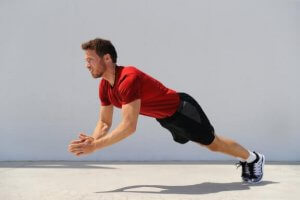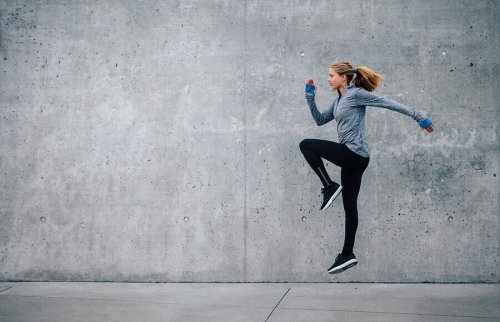What are Plyometric Exercises?

By combining fast movements and strength, we’re performing what the fitness world calls “plyometric exercises”. Would you like to know more about these exercises? Keep reading this article.
Characteristics of plyometric exercises
If we stick to its definition, plyometrics are exercises that include fast and powerful movements. They involve muscle-lengthening actions, while at the same time, activating a cycle of extending and contracting the muscle fibers. The objective is to generate a stronger contraction.
We could say, that if an exercise uses the myotatic reflex caused by stretching, in order to get a stronger response, it’s plyometric.
Perhaps you’ll understand it better with an example: if you want to jump higher, you have to bend your knees to gain momentum. That’s a plyometric exercise! It’s an intense activity, but very effective when we seek to make a rapid movement.
This means that plyometric exercises combine aerobics with strength. They are explosive, fast, and seek to maximize sports practice, as well as strengthen muscles, ligaments, and tendons.
What are plyometric exercises good for?
Many elite athletes opt for plyometric exercises to contract muscles and prepare them to accelerate quickly and powerfully. Without a doubt, sports performance improves with these movements.
That’s not all! They’re also good for recovering from lower level injuries; as long as a physiotherapist or a doctor advises it. These professionals perform two evaluations to check if a patient has recovered:
1. Static stability test
It examines the ability to maintain balance. The individual must stand on the healthy leg for at least 30 seconds with eyes open and then closed. After that, the patient carries out the same process with the injured leg.

2. Dynamic movement test
This test measures the ability to perform plyometric exercises, including explosive movements and different types of jumps.
Advantages of performing plyometric exercises
Among the main benefits of plyometric exercises, we can highlight the following:
1. Strengthening muscles
These workouts increase muscle potency due to the explosiveness we need to perform the exercises. Moreover, they’re perfect for improving coordination, strength, and balance.
2. Injury prevention
If you’ve already been injured on other occasions, you’re likely to be afraid of doing any type of exercise. However, by strengthening your muscles, plyometrics reduces the possibility of reinjuring yourself. It’s also used to prevent contractures and pain.
3. Improvement in your stats
Runners use plyometric exercises since they increase speed and acceleration, two essential qualities needed to reach the finish line faster. Although, they also benefit people who practice athletics, tennis, soccer, and other sports.
4. Weight loss
Even though it’s not the primary objective of plyometric exercises, there’s a noticeable decrease in weight due to the intensity of the movements. As far as aerobic exercises, we can use them to burn calories while we practice them.
How to do plyometric exercises
You don’t have to be a professional athlete or suffering with an injury to do plyometrics. You are able to take advantage of its benefits if you have some previous physical training. That is if you’re going to the gym assiduously or at least if you workout at home.
If you intend to practice plyometric exercises, either at the gym or at home, we recommend you warm up properly as a first step. Stretch your muscles and joints well for five minutes.

Be careful while doing the techniques since that is the best way to get the most out of them and to avoid injuries. Ask a trainer to show you how to do polymetric exercises.
Over time, you can gradually increase the intensity and difficulty of the exercises. Start with the simplest ones, without extra weight. As you gain experience and practice, move to higher levels.
Don’t forget to wear adequate footwear for the workout to protect your feet and ankles and to have good cushioning for rebounding.
Of course, choosing the surface on which you’ll perform the exercises is essential. If it’s not right, you can damage your knees and ankles.
Finally, don’t forget that rest is paramount, both in plyometric workouts and in any other discipline. Don’t go to the gym every day and sleep for at least eight hours each night to stay healthy and perform better.
By combining fast movements and strength, we’re performing what the fitness world calls “plyometric exercises”. Would you like to know more about these exercises? Keep reading this article.
Characteristics of plyometric exercises
If we stick to its definition, plyometrics are exercises that include fast and powerful movements. They involve muscle-lengthening actions, while at the same time, activating a cycle of extending and contracting the muscle fibers. The objective is to generate a stronger contraction.
We could say, that if an exercise uses the myotatic reflex caused by stretching, in order to get a stronger response, it’s plyometric.
Perhaps you’ll understand it better with an example: if you want to jump higher, you have to bend your knees to gain momentum. That’s a plyometric exercise! It’s an intense activity, but very effective when we seek to make a rapid movement.
This means that plyometric exercises combine aerobics with strength. They are explosive, fast, and seek to maximize sports practice, as well as strengthen muscles, ligaments, and tendons.
What are plyometric exercises good for?
Many elite athletes opt for plyometric exercises to contract muscles and prepare them to accelerate quickly and powerfully. Without a doubt, sports performance improves with these movements.
That’s not all! They’re also good for recovering from lower level injuries; as long as a physiotherapist or a doctor advises it. These professionals perform two evaluations to check if a patient has recovered:
1. Static stability test
It examines the ability to maintain balance. The individual must stand on the healthy leg for at least 30 seconds with eyes open and then closed. After that, the patient carries out the same process with the injured leg.

2. Dynamic movement test
This test measures the ability to perform plyometric exercises, including explosive movements and different types of jumps.
Advantages of performing plyometric exercises
Among the main benefits of plyometric exercises, we can highlight the following:
1. Strengthening muscles
These workouts increase muscle potency due to the explosiveness we need to perform the exercises. Moreover, they’re perfect for improving coordination, strength, and balance.
2. Injury prevention
If you’ve already been injured on other occasions, you’re likely to be afraid of doing any type of exercise. However, by strengthening your muscles, plyometrics reduces the possibility of reinjuring yourself. It’s also used to prevent contractures and pain.
3. Improvement in your stats
Runners use plyometric exercises since they increase speed and acceleration, two essential qualities needed to reach the finish line faster. Although, they also benefit people who practice athletics, tennis, soccer, and other sports.
4. Weight loss
Even though it’s not the primary objective of plyometric exercises, there’s a noticeable decrease in weight due to the intensity of the movements. As far as aerobic exercises, we can use them to burn calories while we practice them.
How to do plyometric exercises
You don’t have to be a professional athlete or suffering with an injury to do plyometrics. You are able to take advantage of its benefits if you have some previous physical training. That is if you’re going to the gym assiduously or at least if you workout at home.
If you intend to practice plyometric exercises, either at the gym or at home, we recommend you warm up properly as a first step. Stretch your muscles and joints well for five minutes.

Be careful while doing the techniques since that is the best way to get the most out of them and to avoid injuries. Ask a trainer to show you how to do polymetric exercises.
Over time, you can gradually increase the intensity and difficulty of the exercises. Start with the simplest ones, without extra weight. As you gain experience and practice, move to higher levels.
Don’t forget to wear adequate footwear for the workout to protect your feet and ankles and to have good cushioning for rebounding.
Of course, choosing the surface on which you’ll perform the exercises is essential. If it’s not right, you can damage your knees and ankles.
Finally, don’t forget that rest is paramount, both in plyometric workouts and in any other discipline. Don’t go to the gym every day and sleep for at least eight hours each night to stay healthy and perform better.
All cited sources were thoroughly reviewed by our team to ensure their quality, reliability, currency, and validity. The bibliography of this article was considered reliable and of academic or scientific accuracy.
- Quetglas, Z., Iglesia, O., & Martinez, R. (2012). Fundamentos biomecánicos del ejercicio pliométrico. Lecturas: Educación Física y Deportes, Revista Digital.
This text is provided for informational purposes only and does not replace consultation with a professional. If in doubt, consult your specialist.








